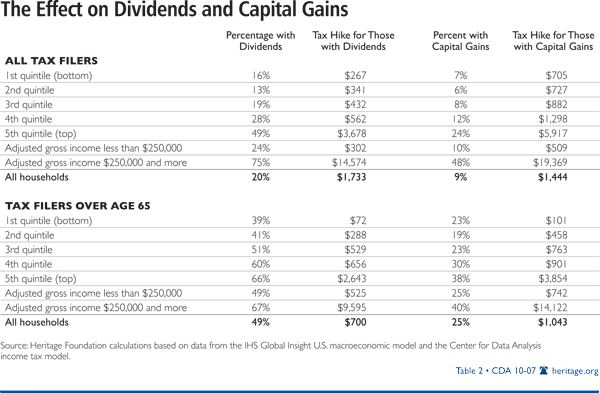Abstract: Since 1996, Congress after Congress has voted to lighten the tax burden on Americans. The current Congress will decide this fall whether to continue this policy or to significantly raise personal income taxes. President Obama has advanced a plan that reverses the long-standing successful policy: The President and his supporters are calling for tax increases, primarily on upper-income taxpayers and businesses— including small businesses, the primary job creators in the country. Those who will be most burdened if this plan becomes law are the millions of Americans just starting their economic lives and the millions more trying to find work after the worst recession in 60 years. The rest, whose lives are affected by the investments and business decisions of those taxpayers in the high-income classes, will share the burden. No income earner will be unscathed. Instead of extracting more income from the private economy, Congress should immediately reduce its spending and enact fundamental entitlement reform that supports strong economic growth. Heritage Foundation economists explain why employment and the economy cannot be made to grow through higher taxes—and how crucial it is for Congress to recognize this fact.
The Members of the U.S. House and Senate are about to engage in one of the most consequential tax policy debates of the past 50 years. At stake is the nation’s tax policy. For 14 years, Congress after Congress has voted to lighten the tax burden on taxpayers. The current Congress will decide later this fall whether to continue this successful policy and extend the tax relief laws currently in force or significantly raise personal income taxes.
Two developments have prompted this historic policy debate. On the one hand, tax laws passed in 2001 and 2003 under Congress’s peculiar budget rules means that key tax rates and tax credit or deduction provisions will revert to their higher, pre-2001 levels on January 1, 2011. Congress could, of course, extend these lower rates for a specific time or, preferably, permanently.
On the other hand, President Barack Obama has proposed several changes to tax law in his fiscal year (FY) 2011 budget that would hold tax levels constant for most married taxpayers with incomes below $250,000 and single taxpayers with incomes below $200,000, and raise taxes on those who earn more. Indeed, it is both the impending expiration of lower tax rates and the President’s and congressional leadership’s tax hike proposals that shape this coming debate.
If Congress enacts the Obama tax hike, it will have changed the course of long-standing tax policy. With the exception of the recently enacted Patient Protection and Affordable Care Act (PPACA), no Congress has voted to raise significant sums of new tax revenues since 1996. Indeed, the fundamental tax policy of this country until now has been to reduce tax burdens.[1]
This policy has largely been driven by a bipartisan understanding that lower tax rates support stronger economic growth. Certainly, that view animated the debates over the 2001 and 2003 tax legislation, each of which resulted in lower, though temporary, tax rates and tax liabilities. While the jury is still out on the overall economic effects of Bush-era tax relief, these two changes to tax policy, particularly the 2003 legislation, likely boosted economic activity and strengthened the macro economy.[2]
President Obama, however, has advanced a tax plan that reverses this tax policy.[3] Rather than continuing the pattern of tax reduction and reform, the President and his supporters in Congress and elsewhere are calling for tax increases, primarily on upper-income taxpayers and businesses. Many of these individuals are small-business owners, the primary job creators[4] in the country, whose income often fluctuates from year to year.[5] These tax increases would add approximately $1.8 trillion to government revenues over the next 10 years, of which more than half ($970 billion) would come from upper-income taxpayers.[6] Enacting this tax plan would have serious, adverse consequences for economic activity, and sharply lower the rate of economic growth. This would frustrate the President’s effort to raise these new revenues.
Center for Data Analysis economists estimated the likely economic and fiscal effects of the Obama tax plan by introducing it into a model of the U.S. economy that leading government agencies and Fortune 500 companies use to produce economic forecasts.[7] This economic model, which covers FY 2011 to FY 2020, produced results that are displayed in Appendix 2 of this Report. The Obama tax plan would result in:[8]
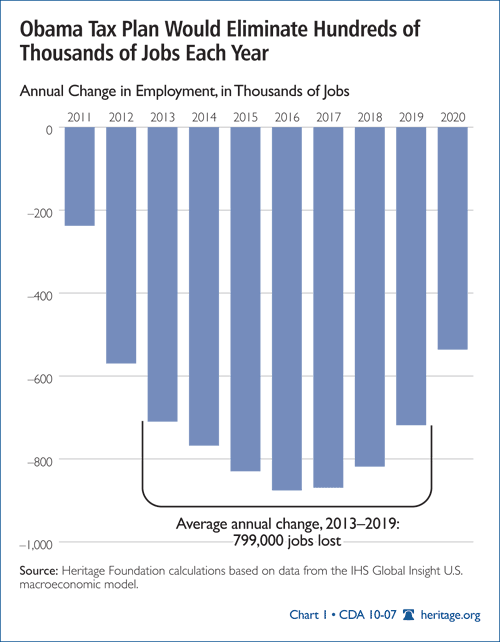
• Slower economic growth: Inflation-adjusted gross domestic product (GDP) would fall by a total of $1.1 trillion between FY 2011 and FY 2020. GDP in 2018 would fall by $145 billion alone. The growth rate of the economy would be slower for the entire 10-year period.
• Fewer jobs: Slower economic growth would result in less job creation. Employment would fall by an average of 693,000 per year over this period
- 238,000 fewer jobs in the critical economic recovery year of 2011;
- In one year alone, 2016, job losses top 876,000.
• More unemployed Americans: Slower growth in employment translates to a higher unemployment rate, which would rise more each year during the 10-year period than it would without the Obama tax hikes.
- In other words, for Americans who are unemployed now, their prospects of employment would worsen under the Obama tax plan.
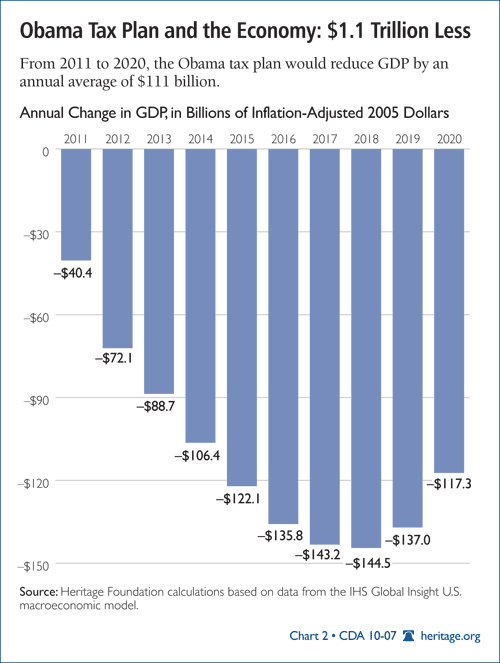
Bad economic news is mirrored by several other key economic indicators:
- Business investment would fall every year of the 10-year period by an average of $33 billion below the level it would be without the tax hikes;
- Investment in residences would also fall by an average of $13 billion each year;
- Personal savings would decrease by $38 billion in 2011 alone, and savings by Americans would continue below baseline for each of the following four years;
- Total disposable lost income after subtracting inflation would equal $726 billion for the 10-year period; and
- Lost consumer spending after inflation would equal $706 billion over this time period.
In short, the economic harm is significant and widespread. Individuals and households throughout the income distribution will bear the brunt of the economic slowdown, resulting in fewer employment opportunities, lower wages, lost consumption, and lower savings. Congress needs to understand that it will raise additional revenues on the backs of those citizens it often works to help through income redistribution programs.
Extending the Bush Tax Relief for Americans Earning Less than $200,000 a Year Is Not a Tax Cut
The President’s budget proposal calls for the repeal of the Bush tax cuts for high-income earners, and an extension—albeit temporary—of these tax cuts for “middle class” earners (individuals earning less than $200,000 per year and households earning less than $250,000 per year). One of the claims made by supporters of the Obama plan is that continuing or extending the Bush tax provisions is equal to a tax cut—which implies a cut in levels and rates of taxation below that of current law. But, given that an extension of current policy is exactly an extension of current levels and rates of taxation, it is clearly false to speak of tax cuts.
Allowing this current policy to expire for any income-earning group can be interpreted in no other way than as a tax increase.[1] In other words, the extension is not meant to— and will not—lower tax levels and rates for these individuals and households below the levels in current law; but expiration most certainly will raise taxes for those affected by the expiration of the tax relief provision.
No matter how one views this policy debate, the notion that it is about whether to endorse a tax cut is logically—and factually— flawed. Rather, the debate is entirely about whether or not to allow the expiration of the 2001 and 2003 Bush tax cut laws for certain groups, or for all taxpayers. Thus, the end of the debate will yield one of two outcomes: Taxes will go up on some or all taxpayers; or taxes will remain the same for everyone.
More Taxes or Less Spending? What Congress Should Do
These adverse economic effects stem entirely from the interaction between President Obama’s tax plan and the economic lives of workers, investors, business owners, and retirees who, daily, create the U.S. economy. While it is widely believed that the President’s plan affects only those taxpayers who earn at least $200,000 ($250,000 if married), that belief is badly mistaken. Nearly everyone will pay something, either in lower income, higher interest rates, or more expensive products, to just name three effects. Economic life at all levels is so tightly interwoven that tax increases for one segment of the population will ultimately affect everyone.
For example, the President has proposed two tax-rate changes for the personal income tax: (1) eliminating the current 31 percent top rate, and (2) introducing two new tax rates—36 percent and 39.6 percent. Single taxpayers with incomes above $200,000 and married taxpayers with combined incomes of $250,000 or more will pay taxes at these new, higher rates.
Upper-income taxpayers generally have greater control over how they receive their income than do taxpayers further down the income scale. Thus, higher-earning taxpayers may decide to reduce their taxable income while keeping their total compensation growing by taking more “income” in the form of non-taxable employee benefits or options to purchase stock in their companies sometime in the future.
That common move to reduce one’s exposure to taxes results in lower savings and less income for investment today. A reduction in the pool of funds for investment that these upper-income taxpayers control directly affects the ever-changing size of investment in new factories, new equipment, and new jobs. In the end, therefore, the upper-income taxpayer who effectively avoids some or all of the new tax affects the lower-income worker through that worker’s job, wage, or working conditions. The economy is seamless, and policymakers who think otherwise often find themselves hurting those who they would otherwise work to protect.
President Obama and his supporters probably recognize these indirect but enormously significant effects. It is highly unlikely that the President’s economic advisors fail to see the connection between rising taxes and slower economic growth. However, these same advisors argue that the need for new revenues outweighs the adverse effects of tax increases. They have studied the growing difference between outlays and inflows and have concluded that new revenues must be part of a financial plan to bring the federal budget closer to balance. After all, there probably is a limit to how long the U.S. government can rely on borrowing to meet its planned spending. Further, efforts to substantially reduce spending often meet insurmountable philosophical and political obstacles.
Even so, the President and his supporters cannot avoid the fact that the deficit problem is primarily located on the spending—not revenue—side of the financial ledger. The Congressional Budget Office now expects federal government spending to equal 24.5 percent of the economy in 2011, its highest level since 1960.[9] At the same time, a weak economy with high unemployment is producing low levels of federal revenues, which likely will result in a 2011 deficit of more than a trillion dollars.
If current policies are continued throughout the next 10 years, revenues will regain their historical average of 18 percent of GDP in 2016, and stand at 18.2 percent of GDP in 2020. But spending is expected to be 26.5 percent of GDP.[10] If revenues return to their historical levels following full recovery from the recession, how can the gaping 2020 budget deficit be the result of anything other than higher than average spending?
The determination of how to address the fiscal problem of the next decade is crucial to the current debate over President Obama’s tax plan. That plan assumes that the U.S. government has a revenue problem, not a spending problem. If Congress agrees, a weak economy will be burdened even more by higher taxes on labor and capital, the tax base will erode as taxpayers adapt their income to higher tax rates, and Congress will move further away from financial solvency. This paper describes those undesirable economic and fiscal outcomes.
Congress could take this historic moment of great fiscal challenge to lay a solid foundation for future fiscal solvency. Rather than inflicting painful tax increases on a sluggish economy, Congress should reform the country’s tax code with the goal of supporting stronger economic growth and creating a simpler, less intrusive system of revenue collection. At the same time, Congress should take a first step toward meaningful entitlement reform. This step is crucial to prevent the oncoming tsunami of debt that the “debt-paying generation” will face if Congress does not get control of the greatest driver of federal spending: exploding outlays for mandatory programs like Social Security, Medicare, and Medicaid.
The Historical Background for the Obama Tax Plan
Some readers may wonder why Congress must now revisit tax policies put in place in 2001 and 2003. After all, Congress reviews tax policy at least once every year. What is so historic about this year’s tax debate?
Part of the answer to that question stems from how Congress passed the 2001 tax relief legislation: Congress adopted special budget rules before the tax legislation’s enactment that allocated a fixed amount of funds for tax relief. In addition, this so-called reconciliation rule required that the tax law expire at the end of the tenth year after its effective date, which would be on January 1, 2011. It is not a peculiarity of this tax legislation that the law expires in 10 years: Legislation adopted under budget reconciliation routinely has a 10-year life, after which Congress can vote to renew it.
However, President George W. Bush began almost immediately to call on Congress to make these tax cuts permanent, which Congress clearly could have done at any time during the intervening 10-year period. Instead, Congress enacted several other tax bills, but not one was extended further than the end of 2010.[11]
This failure does not diminish the importance of Congress’s efforts in the first half of the past decade. In 2003, Congress passed landmark legislation reducing the tax rates on dividends and capital gains. Lowering these key taxes on capital appears to have produced substantial economic gains over the decade.[12]
At the same time, revenues flowed into the Treasury at about the rate that the CBO forecasted in 2000, a full year before the first tax relief legislation was signed. As Chart 3 shows, the CBO forecasted total revenues of $2.7 trillion for 2007 (one year before the Great Recession began) when it issued its 10-year budget outlook in 2000. When the CBO published its 10-year outlook in 2007, it reported revenues for that year of $2.6 trillion, or 96.2 percent of the total it expected seven years earlier and before any knowledge of the tax relief legislation or the recession of 2001. Their forecast for 2008 made in 2007 called for revenues of $2.77 trillion, which would have been 98 percent of the forecast made in 2000.
The Great Recession dramatically changed the nation’s revenue picture, as it did nearly everything else related to the economy. However, the point is this: Revenues after the major tax relief legislation between 2001 and 2005 flowed into Washington at nearly the same rate that the CBO expected before any tax cuts were made. Congress was never starved for revenue.
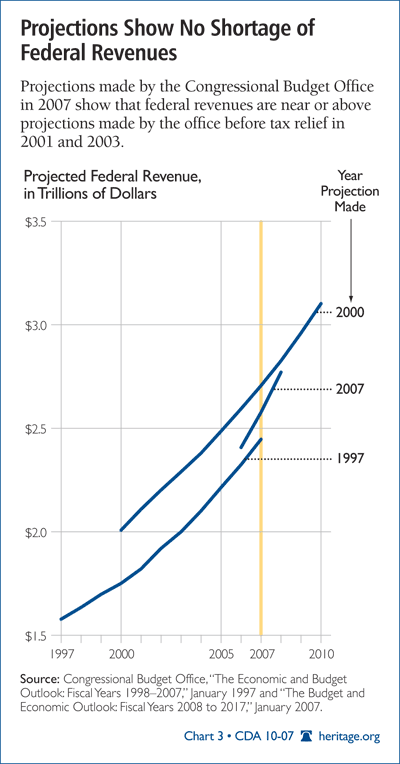
President Obama’s Proposal
President Obama and the congressional leadership are advancing remarkably similar proposals for handling the expiring provisions of Bush-era tax relief. The CDA simulation combines elements from each approach to estimate the effects of a likely compromise scenario.
President Obama’s 2011 budget advances a variety of tax proposals that will affect individual tax filers.[1] The essence of the President’s tax plan is creation of a category of upper-income tax filers and raising taxes on them while maintaining the 2001 and 2003 tax cuts for other tax filers.
The Obama plan will end the marginal tax rate cuts in the 2001 and 2003 tax bills for single filers with adjusted gross income (AGI) of $195,550 and joint filers with an AGI of $237,300.[2] Based on the CDA’s view of what President Obama would like Congress to do, CDA analysts assumed $200,000 and $250,000 respectively for the analysis presented here. President Obama limits the value of these filers’ itemized deductions to 28 percent. In addition, President Obama increases the tax rate on capital gains to 20 percent but retains the link between qualified dividends and long-term capital gains, which will both be taxed at 20 percent. The CDA simulation draws on extensive congressional discussion of letting the dividend tax rate equal the tax rate on ordinary income. In other words, the top dividend tax rate would be 39.6 percent.
On the estate tax and the generation-skipping tax, the President and the congressional leadership agree: Both would raise the top marginal tax rate on taxable estates to 45 percent and provide a taxpayer exemption of $3.5 million in taxable assets.
President Obama increases the phase-out of personal exemptions and deductions for single filers above $200,000 and joint filers above $250,000. Itemized deductions of these same taxpayers would be limited to 28 percent of the deduction. This would make these deductions worth substantially less to taxpayers in the 36 percent and 39.6 percent marginal tax rate brackets. Deductions would be worth 19 percent less for a taxpayer in the top bracket.
President Obama’s budget and the congressional leadership continue many of the 2001 and 2003 tax cuts for taxpayers who are not considered upper-income. For example, the marginal tax rate reduction, the increase in the child tax credit, various education tax credits, and the marriage-penalty relief provisions are kept intact.
President Obama also extends his tax provisions (mostly short-term tax credits) that were passed in 2009 in response to the recession. The Making Work Pay Credit, a credit worth $400 to single filers and $800 to joint filers, with a phase-out starting at $75,000 annual income, is extended for one additional year. The President also proposes another $250 special payment to individuals who receive government pensions. This is exactly the same payment that he proposed in 2009. The bonus depreciation for qualified businesses is also extended another year.
Overall, President Obama’s tax plan has changed very little from the previous year’s budget. The President wants to raise taxes on upper-income taxpayers, but keep the 2001 and 2003 tax cuts for other taxpayers. The President is keeping many of the “temporary” tax cuts enacted in the 2009 stimulus bill.
[2]The values reflect $200,000 for singles and $250,000 for joint filers minus personal exemptions and standard deductions, indexed to 2009.
How the Obama Plan Will Affect Taxpayers
President Obama vowed not to raise taxes on those households earning less than $200,000 per year. His health care legislation already broke this promise, and now he seems adamant about raising taxes on those above this income level, allowing the top income tax brackets to revert to their pre-2001 levels.
Obama proposes a return of the highest marginal tax brackets, including the 39.6 percent bracket, a return to the treatment of dividends as regular income (subject to the 39.6 percent bracket at the higher levels) and a return of the personal exemption phase-out (PEP) and limits on deductions for high-income (starting around $140,000) households (the Pease provision, named after the late Representative Donald J. Pease (D–OH)) in order to determine the effect of these policies on taxpayers. These proposed tax increases were simulated using the CDA Individual Income Tax Model. The policy changes were run together as a single simulation to allow interactions between them. This simulation was then compared with a simulation of current policy. Altogether the proposed tax increases would raise the effective marginal rate on households earning above $200,000 filing singly or $250,000 filing jointly in 2011 by 6.9 percent (to 38.2 percent), and raise their effective average rate by 2.8 percent (to 25.9 percent).[13] The Obama Administration has argued that the tax code should be more progressive, despite already being the most progressive in the developed world.[14] Upper-income filers already pay the lion’s share of personal income taxes. Although the 2001 and 2003 tax cuts initially reduced the burden on the top 1 percent of tax filers from 22.2 percent to 20.1 percent, by 2007 the top 1 percent were paying more than ever: a full 40 percent. During a recession, the portion of taxes paid by the wealthiest usually drops, as capital income falls. In 2010 the top 1 percent will pay about 35 percent of total personal income taxes. However, if the top marginal rates are raised again, the top 1 percent would carry the burden of 38 percent instead of 35 percent even in a projected recessionary 2011.
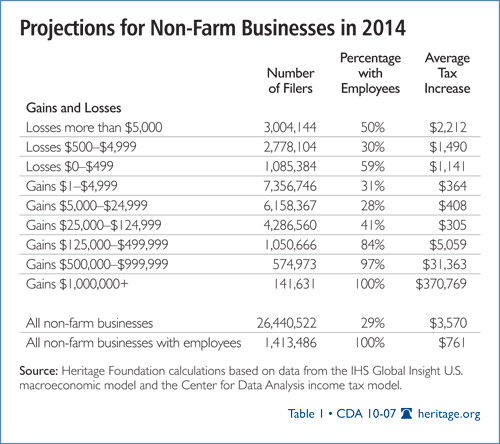
Small businesses would be hit hard; 65 percent of joint filers with income above $250,000 and 50 percent of single filers above $200,000 earn business income. The numbers are not too different if only businesses reporting wage costs are counted: They are 55 percent and 42 percent, respectively. In other words, about half of those subject to the Obama tax increases are small businesses with employees. This tax increase would directly cut job creation.
The average non-farm small business filing through the individual income tax code would see a tax increase of about $3,500. Not only successful businesses would be hurt, although they would be hurt the most. Even firms with losses could face a tax increase, for example on capital gains, dividend, or carry-over income.
Any tax filer with capital gains or dividend income would also face a tax increase. Filers at all income levels, especially seniors, earn—and depend on—capital gains or dividend income. Higher-income filers are more likely to have capital gains and dividend income, but filers of every income quintile can have income from these sources and would see a significant tax increase if they do. Even in the lowest income quintile, 16 percent of tax filers have dividend income, and these filers would see an average tax increase of $267. Nearly 20 percent of filers in the middle quintile and nearly 30 percent of filers in the fourth quintile have dividend income, and the tax increase for these filers would be about $430 and $560, respectively. The percentage of filers with capital gains income in the lower quintiles is smaller, but for those with capital gains income, even in the first three quintiles, the average tax increase would be much larger.
Many seniors rely on capital gains or dividend income as part of their retirement plan. In fact, for many of these older tax filers, it is their primary income source. Almost 40 percent of seniors in the lowest income quintile have dividend income, and 23 percent have capital gains income. For the 50 percent of seniors in the third quintile that have dividend income, the tax increase would be a hefty $529 on average, and for the 23 percent with capital gains income it would be $763. Sixty percent of seniors in the fourth quintile receive dividends and 30 percent have capital gains income; the tax increase for these middle-class seniors would be $656 and $901 respectively. Overall, more than eight million tax returns are filed by seniors with qualified dividend income.[15] Of course, for seniors in these middle-income categories that have both capital gains and dividends in their retirement portfolio, the tax increase would be even greater.
How the Obama Plan Will Affect Economic Activity
Brief Description of the Dynamic Simulation. The dynamic macroeconomic analysis conducted by the Center for Data Analysis assumes that individuals and businesses react to real-world changes in income and costs. As a result, changes in economic growth that reflect changes in income can lead to higher or lower tax receipts than under the static scoring.
Tax changes also affect economic growth, largely through the way they affect the cost of productive factors. Thus, a tax increase may slow down economic activity by increasing factor costs, which in turn reduces the rate of growth in tax revenues below what static analysis would predict.
Macroeconomic Simulation. CDA analysts used a version of the IHS Global Insight (GI) July short-term structural model of the U.S. economy. CDA analysts used a version of the GI model that has been adjusted to represent current policy.[16]
Similar to any baseline used in a macroeconomic simulation, the baseline is important since it is the comparison to the counterfactual—or alternative scenario—view of the economy. The adjusted baseline in this paper represents a forecast of future economic activity based on maintaining current tax policy. A simulation of President Obama’s tax plan is compared to this baseline of current policy, and the differences represent the economic effect of the President’s plan.[17]
Dynamic Economic Effects
Lower Economic Output. GDP will be, on average, $111 billion lower over the 2011 to 2020 forecast horizon. The projected slowdown in the U.S. economy will result largely from significantly reduced incentives to save and invest in productive capital and technology through higher capital gains and dividend taxes. The productive capacity of the economy is also lowered by the disincentive for high-income individuals to supply their labor due to the higher marginal tax rates on income.
Arguably, many high-income individuals earn their income from capital income rather than labor income. However, at the macro (aggregate) level, the marginal effects of tax rates also affect individuals on the cusp of moving into the high-income brackets. Therefore, it is not only current high-income individuals who are discouraged from supplying their labor, but also those who, through a little more labor supply, would find themselves in the high-income bracket. Economic stagnation frequently results from just this “unseen” event: Someone somewhere simply does not work harder or more cleverly because of high taxation; and the result hurts everyone through slower economic growth.

Reduced Employment. Total employment would decrease by an average of 693,000 jobs over the 2011 to 2020 forecast horizon. Annual job losses would peak at 876,000 in 2016, and would continue to fall, albeit at a slower pace, through 2020. This forecast path would delay any sort of recovery in the labor market.
The employment losses are caused by the direct and indirect effects of the higher tax rates on labor and capital. The direct effect happens at the margins where individuals choose to supply less labor due to the higher marginal tax rate. This is a relatively small effect when compared to the indirect effects that are set in motion by the changes in decisions to invest and grow the productive capacity of the economy. The higher capital income tax and the increased disincentives for saving and investment will likely force business owners to operate below potential and decrease their (planned and actual) investment in new equipment. A slowdown (or even continued pullback) in real business investment will lead to decreased levels of economic output that, in turn, will cause wages and salaries to be lower than they otherwise could have been, or cause employment levels to be lower.
Capital gains also represent the additional value that entrepreneurs create when they implement new technologies, find better ways to make or deliver products and services, or introduce a better product or service to the market. Often these entrepreneurs will start a new company. Higher capital gains taxes discourage potential entrepreneurs who must already overcome the riskiness of the endeavor (i.e., the possibility of earning little or no return), borrowing, or other financing costs of the endeavor, as well as myriad other tangible and intangible constraints when deciding whether to become an entrepreneur.[18]
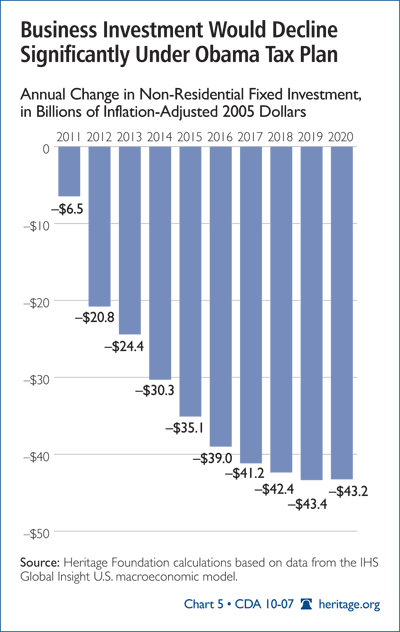
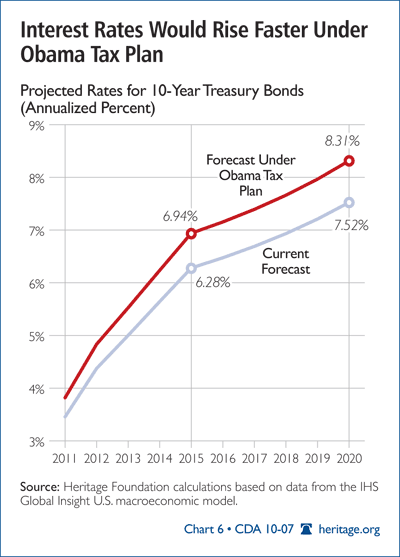
Decrease in Personal Income and Consumption. Income is the means for consuming. Income growth below baseline or potential implies that consumption will also be below potential. Overall personal consumption would fall by $71 billion over the 2011 to 2020 forecast horizon. Under the President’s tax plan, disposable personal income declines on average by $223 for an individual and $844 for households (based on a family of four) between 2011 and 2020.
Real Investment Changes. Higher tax rates discourage investment by lowering investment’s return. Higher personal income tax assessments directly cut the pool of funds available for investment, which combines with lower returns to slow down economic activity. Lower investment reduces the growth of output, which adversely affects job creation. The dynamic results show gross private domestic investment down by $470 billion, and non-residential fixed investment down by $330 billion over the 2011–2020 forecast horizon.
Lower investment today means less growth of productive resources in the future, which leads to fewer resources available for future investment. The result is lower levels (and rates) of investment for each year of the 10-year forecast period. This compounding feedback effect can be seen in the growing differences between the baseline and President Obama’s tax plan (see Appendix 2). Not accounting for this sort of compounded feedback effect would grossly underestimate the real impact on investment, output, and employment in the economy.
Fiscal Effects. Dynamic forces shape the overall economy, so raising these tax rates will have dramatic effects on the corporate and personal tax base. As a result of the President’s tax plan, business investment—notably gross private fixed and nonresidential fixed investment—and private employment will steadily fall below the baseline levels over the entire 10-year horizon. When the incomes of households and businesses fail to grow at the rate assumed in the government’s revenue forecasts, income for the federal government is lower than expected. That result occurs in the CDA simulation. The dynamic model of the economy estimates that the revenue effects of the higher tax rates are only about 34 percent of the static revenue estimates from 2011 to 2016. That is, the revenue created by the higher tax rates will be only about 34 percent of static projections of tax revenue. Furthermore a weaker economy, lower wages, and lower employment lead to fewer payroll taxes. With no entitlement reform, entitlement spending will continue to rise at a fast pace, leading to increased unified budget deficits of an additional $7.2 billion by 2020.[19]
Conclusion
For the authors of the Obama tax plan, these economic results should be highly frustrating: lower than expected revenues, higher than expected unemployment, and slower overall economic activity. However, the description of the economic effects of the Obama tax plan contained in this paper are entirely consistent with economic theory: If the price of capital and labor increases through a tax increase, the pace of economic activity will slow down.
Those who will be most frustrated if this plan becomes law are the millions of Americans just starting their economic lives or the millions more trying to find work after the worst recession in 60 years. Those who will shoulder the burden of this proposed tax increase will not be only those Americans with relatively high incomes, but all the rest whose lives are affected by the investments and business decisions of those taxpayers in the high-income classes.
Congress could take a different path in this fiscal crisis. Instead of extracting more precious income from the private economy, Congress should take immediate and vigorous steps to reduce its spending. As argued in this paper, spending, not revenue, is the problem. In truth, however, even that does not touch the true source of America’s public finance challenge. In the end, Congress must come to terms with the need to find a new fiscal balance point through lower spending and fundamental entitlement reform that also supports strong economic growth. Congressional policymakers will not achieve that balance with higher taxes.
—William W. Beach is Director of the Center for Data Analysis (CDA) at The Heritage Foundation; Rea S. Hederman, Jr., is Assistant Director of and Research Fellow at the CDA; John L. Ligon is a Policy Analyst at the CDA; Guinevere Nell is Research Programmer at the CDA; and Karen A. Campbell, Ph.D., is Policy Analyst in Macroeconomics at the CDA.
Methodological Appendices
Appendix 1: Microeconomic Methodology
Changes to the individual income tax code were simulated using the Center for Data Analysis (CDA) Individual Income Tax Model in order to estimate effects on tax revenue and the distribution of the resulting tax burden and to compare these effects to current policy estimates.
The CDA tax model simulates the effect of tax law changes on a representative sample of taxpayers based on IRS Statistics of Income (SOI) taxpayer microdata. Data for these taxpayers are extrapolated or “aged” to reflect detailed taxpayer characteristics through 2016. The data are aged for consistency with the Congressional Budget Office (CBO) baseline forecast in order to produce effective and marginal tax rate estimates with which to forecast dynamic effects of the changes in tax burden.
Two simulations were run for comparison: current policy extended forward through 2016, and the proposed tax increase on upper-income filers by the reversal of the 2001 and 2003 reduced top marginal rates. The tax increase includes a return of the 39.6 percent, 36 percent, and 28 percent brackets for a total of six brackets (10 percent, 15 percent, 25 percent, 28 percent, 36 percent, and 39.6 percent); the treatment of dividends as regular income, subject to those six brackets; a return of the 20 percent capital gains bracket; and the return of the phase-out for itemized deductions and personal exemptions (PEP and Pease).
These policy changes were run together as a single simulation to allow interactions between them. This simulation was then compared with a simulation of current policy. Both simulations included recent tax changes such as:
- The new Making Work Pay credit;
- Scheduled “patches” and changes in the alternative minimum tax (AMT) and education credits (Hope, Lifetime Learning, and the American Opportunity tax credit); and
- Tax increases that accompany the recently passed health care bill. The Medicare Hospital Insurance tax is increased by 0.9 percentage point and applied to capital gains income for those with incomes above $250,000 (joint filers) or $200,000 (all others), and itemized deductions for out-of-pocket medical expenses are limited to expenses above 10 percent of adjusted gross income (AGI). The current threshold is 7.5 percent.
For each simulation, average effective tax, marginal effective tax rates, and revenue were calculated for use in the macroeconomic model. Tax burdens for demographic groups were determined based on the simulated filing status and taxpayer information. Non-farm businesses were defined as those tax filers that reported other-than-zero business income through Schedule C or as a partnership or S-Corp through Schedule E.
Appendix 2: Macroeconomic Analysis
IHS Global Insight July Short-Term Model
CDA analysts used a version of the IHS Global Insight July 2010 short-term model of the U.S. economy to estimate the overall net economic effects of President Obama’s tax plan. The version used an adjusted baseline representing the most likely path of the U.S. economy if the government extends the current policies over the next 10 years.
The relationships in the model are calibrated by historical U.S. data and mainstream economic theory. The model is a tool that provides insight into likely magnitudes and the direction of economic variables due to policy changes. A dynamic analysis of a policy change is important because in an ever-changing and market-based economy, indirect and feedback effects need to be taken into account to get a true estimate of the likely overall economic impact.
Direct effects happen, for example, when many individuals make small changes in their labor and leisure trade-off decisions. These changes, in turn, change capital–labor trade-offs made by businesses. The macroeconomic model estimates these changes in relative prices dynamically such that these changes affect investment and output levels. Tax-rate changes also affect disposable income and demand variables.
These have further feedback effects with supply variables as well as interaction with the fiscal revenues and spending variables. The feedback effects further increase or decrease the longer-term impact of the policy, providing a quantitative picture of whether the economy would tend to be stronger or weaker if the proposal were implemented compared to its baseline.
Description of the Adjusted Baseline. CDA analysts used a version of the IHS Global Insight July 2010 short-term model of the U.S. economy to estimate the overall net economic effects of President Obama’s tax plan.
This version of the IHS Global Insight (GI) July 2010 short-term model of the U.S. economy was employed so its baseline fiscal and economic projections would reflect as close to current policy as possible—primarily assuming extensions of the 2001 and 2003 tax relief for all income earners.
This adjusted baseline also reflected an overall faster growing economy relative to the unadjusted GI July 2010 short-term model, and is a close approximation of a current policy baseline.[20]
In adjusting the GI July 2010 short-term model, CDA analysts made the following assumptions: First, the effective personal income tax rate was lowered in the adjusted baseline by removing assumed tax increases on high-income earners starting in 2011 and a gradual increase in effective federal tax rates on all income earners beginning in 2012.[21]
Second, the maximum marginal tax rate on personal capital gains was lowered by removing the assumed increase on this tax rate of 5 percent—an assumed increase from the current maximum rate of 15 percent to 20 percent, including the 3.8 percent increase in the Medicare investment tax which take effect at the start of 2013.
Third, the average federal marginal tax rate was lowered by removing the increase due to the higher marginal tax rates assumed in the GI July 2010 short-term model.[22]
Fourth, a flat revenue amount was subtracted from an adjustment variable (GFRCPTUNIADJ— reconciliation item between NIPA and unified federal outlays in billions of dollars, quarterly rate, Global Insight) in the GI July 2010 short-term model since this model assumes an increase of approximately $32 billion to $33 billion per year from 2011 to 2020 due to the renewal of the estate tax. While there is a seasonal pattern in the revenue adjustment—primarily reflecting the difference in timing between cash receipts in the unified budget accounts and tax accruals in the National Income and Product Accounts (NIPA)—there is no assumed seasonal variation on the estate tax receipts.
Description of the Macroeconomic Simulation. The IHS Global Insight short-term model is largely an econometrically estimated model of the U.S. economy which combines both demand-side (Keynesian) and supply-side features.
Because the tax policy will largely have its effect through changes in decisions affecting the supply side first, CDA analysts made assumptions on interest-rate variables in the simulation to incorporate these initial supply-side effects of the model on investment and capital costs.[23] Changes in capital costs will drive the supply-side changes in level (and rate) of investment, which allows the model to adjust and estimate the effects of the type of policy considered.
The macro simulation made changes to the variables that would be directly affected by the President’s tax plan. The following outlines the changes to the GI variables that could be captured in the GI model relating to the President’s tax plan:
Average Marginal Tax Rates. In the macroeconomic model, overall average marginal tax rates were changed by the amount simulated by the microsimulation tax model for individual filers (see Appendix 1). CDA analysts adjusted the GI variable (RTXPMARGF) that directly measures the average federal marginal income tax rate using percent changes from the baseline instead of the actual estimate to minimize biases in the estimate due to slightly different baseline values between the micro and macro models.
Average Effective Personal Tax Rates. The average effective federal personal income tax rate (RTXPGF) was changed by the percent change that was estimated by the microsimulation (see Appendix 1).
Labor Participation Rates. Changes in marginal personal tax rates alter the after-tax return on the marginal dollar of labor income. Microeconomic theory suggests that increases in the marginal after-tax return on labor also increase the incentive to work and, therefore, labor force participation. In other words, taxes on labor affect labor-market incentives. Aggregate labor elasticity is a measure of the response of aggregate hours to changes in the after-tax wage rate. These are larger than estimated micro-labor elasticities because they involve not only the intensive margin (more or fewer hours), but also, and even more so, the extensive margin (expanding the labor force).[24] The change in the GI variable measuring the average work week (in hours) was estimated using a macro-labor elasticity of 0.10.
In addition, the simulation modeled how changes in personal income tax rates would affect work incentives by estimating the amount that the labor force participation rate in the model would change in response to the individual income tax rate changes in the President’s plan. The GI variables measuring the estimated labor force (ages 16 to 64; and 65 and older) are stochastic variables in the model. In order to capture feedback effects in the model—the tax rate changes as part of the President’s plan would likely alter man-hours due to labor demand and supply interactions (due to changes in optimal capital and labor ratios, for example)—the add factor of two GI variables measuring the labor force (NLFC15T64 and NLFC65A) were adjusted by the direct elasticity effect so that the variables could still be affected by other indirect effects.
Capital Costs and Estate Tax. In the GI model, this tax is part of the unified budget revenues but it is not counted in the NIPA for government receipts. Therefore, an adjustment variable (GFRCPTUNIADJ) in the model reconciles the two government revenue variables. The amount added to the NIPA accounts for estate-tax revenue in the adjusted baseline was obtained from IHS Global Insight.
The model does not “know” that this revenue increase is due to extension of the death tax. In order to allow the model to estimate the indirect effects correctly, the direct effect on corporate interest rates was changed for the simulation. This capital cost-adjustment was made by assuming an increase in the GI variable that tracks the yield on AAA-rated corporate bonds as well as the GI variable that tracks the yield on the 10-year Treasury notes.[25]
